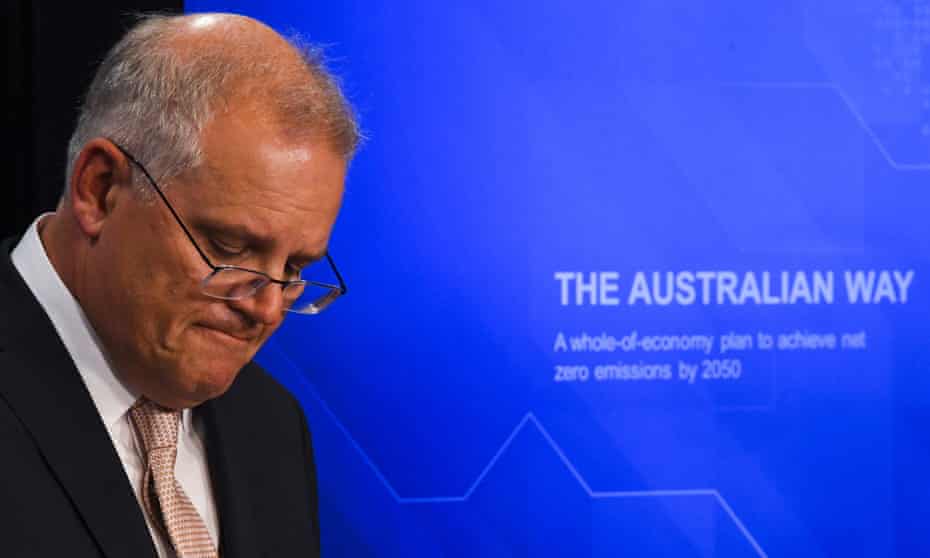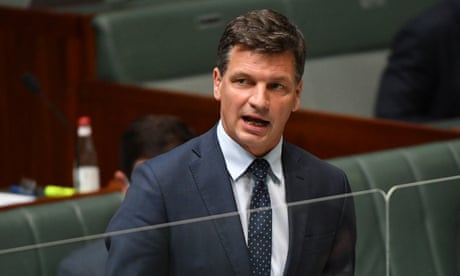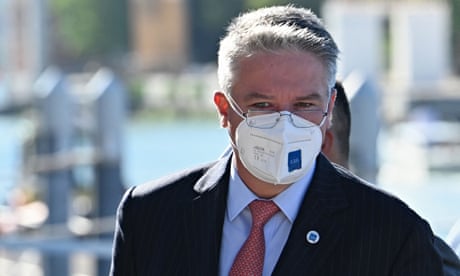Extract from The Guardian
Estimates for carbon dioxide storage in trees and soil go far beyond upper bounds of what peer-reviewed science suggests is possible.

The Morrison government’s long term emissions reduction strategy, released ahead of Cop26, was criticised for not including new policies and relying on new technology.
Last modified on Sat 30 Oct 2021 06.01 AEDT
The Morrison government’s 2050 net zero emissions plan relies on a “gross manipulation” of data that suggests trees and soil can absorb far more carbon dioxide than is actually possible, according to experts in the field.
The government’s long term emissions reduction strategy, released ahead of a major climate summit in Glasgow starting on Sunday, was criticised for not including new policies and relying on new technology to make deep cuts in greenhouse gas emissions in the 2030s and 2040s.
It assumed 10-20% of the emissions cut needed by 2050 would come from paying for international and domestic offsets, including planting trees and other vegetation on marginal agricultural land and techniques to improve the health of soil. This would allow some fossil fuel industries to operate beyond 2050 by effectively cancelling out their emissions by drawing carbon dioxide from the atmosphere.

The government has not released the modelling underpinning the plan, but the strategy document suggests 63m tonnes of carbon dioxide a year could be sequestered in trees and other vegetation and potentially more than 103m tonnes a year could be stored in soil on cropping and grazing land.
Several experts told Guardian Australia these estimates went beyond the upper bounds of what publicly available peer-reviewed science suggested was possible.
“Soil carbon will not be enough to offset agricultural emissions, let alone the coal industry,” he said. “The idea we can bail out the coal industry with soil carbon is just fanciful.”
Polly Hemming, a carbon offsets expert with the Australia Institute, a progressive thinktank, said the government’s strategy assumed tree planting could capture 42 tonnes of carbon dioxide per hectare each year. But the most you could store in optimum conditions – in giant mountain ash forests, for example – was about half that: roughly 19 tonnes per hectare each year for up to 25 years, she said.
“There’s just no way you could ever get to that 42m tonnes a year they are talking about, especially because they are talking about using marginal lands,” Hemming said.
On soil carbon, the government report said there was limited data available on how much could be stored across Australia, but cited two estimates. The first, by CSIRO, suggested 35-90m tonnes could be stored annually. The second and more prominent in the report was by AgriProve, a soil carbon business that earns revenue through the government’s emissions reduction fund. It said there was potential for at least 103m tonnes annually to be stored across the country.

Eckhard said it made little sense that the government would use data from a business working in the area as it created a potential conflict of interest. “Why did the government not go to the best soil science available?” he said.
Hemming said the government had assumed that up to 4.5 tonnes of carbon dioxide could be stored per hectare of soil each year, when the published science suggested the upper limit in optimal conditions was about 1.8 tonnes per hectare. “Best practice science that’s publicly available says this isn’t credible,” she said.
She said the government strategy did not seem to acknowledge that a stand of trees or piece of land could not keep sequestering carbon dioxide indefinitely as each would eventually reach equilibrium and not be able to store any more. Both Eckhard and Hemming said it also did not factor in the impact of climate change-enhanced bushfires and drought on natural carbon stores.
Eckhard said soil carbon in Australia was 90% dependent on rainfall, and that was expected to decline in many areas. “Why would we hedge our future climate change strategy on something that climate change itself is going to challenge?” he said.
Bill Hare, a scientist and chief executive of Climate Analytics, said the strategy had confirmed the government was exaggerating the amount of carbon dioxide that could be stored in the land. “It’s a gross manipulation of what’s possible,” he said.
He said the report suggested the government’s technology-led approach could lead to as little as a 66% cut in actual emissions by 2050 compared with 2005 levels, and leave up to 215m tonnes a year that was supposed to be addressed through domestic and international offsets.
The government has backed the data in the strategy as coming from the CSIRO and energy department.
Angus Taylor, the emissions reduction minister, said on Thursday he would use the Cop26 climate summit in Glasgow to promote Australia as a “safe and reliable” place to invest in gas, hydrogen and “new energy technologies”. He will join the prime minister, Scott Morrison, at the summit following a meeting of G20 leaders in Rome this weekend.
Taylor said the most important legacy Cop26 could have was “a genuine, global commitment to a step up in collaboration on the technology solutions needed to achieve net zero”. But the summit will largely focus on commitments to cut emissions over the next decade.
The Morrison government has resisted calls to increase Australia’s short-term goal beyond that set under Tony Abbott six years ago – a 26-28% cut by 2030 compared with 2005 levels. It puts it at odds with the British hosts, the US and the European Union, which have stressed that developed countries need to cut emissions in half by 2030.
Selwin Hart, the UN secretary general’s special adviser on climate change, this week criticised Australia’s approach. “Where countries are depending on technologies that have not yet been developed, or indicating they intend to cut in the 2030 and 2040s, quite frankly, that’s reckless and irresponsible,” he said.
A UN report this week found the world was falling short on emissions reduction and would face disastrous temperature rises of at least 2.7C unless countries strengthened their pledges.
No comments:
Post a Comment